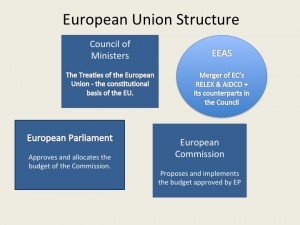EU 101: A brief explanation of the EU structure and what is important from a development standpoint.
My previous posting dealt with issues you would need to consider when considering entering the EU market for development funding. This post is more of an overall review on the funding options within the EU structure. Within the last 2 years, the European Union (EU) has gone though significant changes in its internal structure with the introduction of the High Commissioner and the European External Action Committee (EEAS). This change caused some instability, as staff responsibilities and division mandates went through multiple overhauls, and for a least a year, staff did not know what tomorrow would bring. This insecurity still remains somewhat as the EU institutions are working on a new financial framework for 2014-2020.
Under the new structure there are 4 important institutions critical to disbursement of development aid:
- The Council of Ministers,
- The European Parliament (EP),
- The European Commission (EC) and
- The newly formed European External Action Committee (EEAS).
Organizations unfamiliar with the EU often focus on the obvious European Commission, but please do not ignore the other 3 equally important, if not more important institutions regarding development policy.

The Council of the European Union is the principal decision making institution in the EU. It is often informally called the Council of Ministers or just the Council, the name used in the treaties; it is also called Consilium. It is the more powerful of the two legislative chambers, the other being the European Parliament. The Council sets the Treaties of the European Union: a set of international treaties between the Union’s member states that sets out the constitutional basis of the EU and sets the various Development policies. Just to make it more complex, this Council should not be confused with the European Council (an assembly of EU heads of state or government), or confused with the Council of Europe (a non-EU organization of 47 states).
European Parliament (EP): The EP approves and allocates the budget, including that of development aid of the European Commission. The official office is in Strasbourg, (France), committees are held in Brussels (Belgium) and the secretariat is located in Luxembourg.
The European Commission proposes and implements the budget approved by the European Parliament, including the budget for Development and Cooperation (EuropeAid). They decide where and how the funding should be spent.
Set up in 2010, The European External Action Committee (EEAS) is unique and independent from other EU institutions, formed by merger of the external relation departments of the Council and the European Commission. It also has its own independent budget. Depending in your area of interest, the EEAS may be very important to your outreach plan. Organizations focused in the areas of democracy, human rights and defense should emphasize EEAS within their EU outreach strategies. The EEAS manages general foreign relations, security and defense policies and controls the Situation Centre. However, although the EEAS can prepare initiatives, member states make the final policy decisions and the Commission also plays a part in technical implementation. The EEAS has desks dedicated to all the countries and regional organizations in the world, and specialized units for democracy, human rights and defense.
The EEAS has six geographical departments (directorate) headed by a managing director. The departments divide the world into: 1) Africa, 2) Asia, 3) Americas, 4) the Middle East and Southern Neighbourhood, 5) Russia, the Eastern Neighbourhood and the Western Balkans and 6) Global and Multilateral Affairs.
Where does Development program funding come from?
It is important to note that the EU institutions are working on a new financial framework 2014-2020. Therefore the instruments below are subject to change.
Development aid is financed directly by the EU budget (70%) as part of the financial instruments for external action and also by the European Development Fund (EDF) (30%).
EuropeAid was formed on 1 January 2011 following the merger of what was formally known as AIDCO (program implementation) and DEV (policy & program design). EuropeAid has both geographic and thematic directorates and funding mechanisms that correspond. EuropeAid funding mechanisms are divided into geographic and thematic instruments
Geographic Instruments
- Development Cooperation Instrument (DCI)
- European Neighbourhood & Partnership Instrument (ENPI)
- European Development Fund (EDF)
Thematic Instruments
- Development Cooperation Instrument (DCI)
- Environment and Sustainable Mgmt
- Investing in People
- Food Security
- Migration & Asylum
- Others
- Food facility
- Common foreign & security policy
- Instrument for stability
- Democracy & Human Rights Instrument (EIDHR)
- Macroeconomic Assistance
- Nuclear Safety
The Development Cooperation Instrument (DCI) covers geographic, thematic and 18 ACP sugar protocol countries. It is currently the largest financial instrument under Budget of the European Union’s Heading 4 (Global Europe) with €2.9 billion in the 2012 budget.
The European Neighbourhood Partnership Instrument covers counties that border Europe from the Mediterranean to Eastern Europe including Russia. The budget for 2012 is €2.3 billion.
The European Development Fund (EDF) is the main instrument for European Union (EU) aid for development cooperation in Africa, the Caribbean, and Pacific (ACP Group) countries and the Overseas Countries and Territories (OCT). Funding is provided by voluntary donations by EU member states. The EDF is subject to its own financial rules and procedures, and is managed by the European Commission (EC) and the European Investment Bank. On average the EDF has EUR 3.78 billion annually available.
How are decisions made?
Per the 2007 – 2013 Framework, programs are implemented on the basis of thematic strategy papers and annual action programmes. Programs are set by each country and region through Strategy Papers that are set every 5 years or so. These National and Regional Indicative programs define development policy. The Annual Action Programmes (AAP) define the framework and description of the operations to be financed. Written tenders for EU funding should correspond to Strategy Papers and AAPs.
Also important to note is that management of most EC external aid has been devolved to Delegations in the field. This is often called deconcentration. Therefore, country delegations have more say in the management of funds, they can launch country-specific calls for proposals and sign, manage and monitor grants and contracts. However, they may not have the final decision on spending: Brussels may still be involved.
Avoiding the myriad of directorates and decision-makers in Brussels is not an option: a multi-prong approach is recommended if you want to approach the European Union for potential funds in the future. This topic will be covered in Part 3 of this series.


